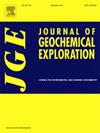人类纪:环境地球化学中一种区分自然背景异常的新方法
IF 3.3
2区 地球科学
Q1 GEOCHEMISTRY & GEOPHYSICS
引用次数: 0
摘要
评估地球化学背景对于解决土壤污染问题至关重要,特别是在自然地质环境与人类活动之间存在复杂相互作用的地区。区分地球化学背景和人为异常的传统方法往往难以解释这些地区的重叠信号,从而导致准确识别污染源的局限性。本研究介绍了“人类纪”方法,这是对“地球化学基因”方法的一种改编,最初是为采矿应用而开发的。通过对与城市和农业污染相关的地球化学指标(“基因”)进行分类,人类世为区分人为异常与自然地球化学信号提供了一个强大的框架。该方法应用于意大利坎帕尼亚地区的大约3000个表土样本,可以确定与城市和农业污染源相关的多元地球化学模式。被认为受污染的样本从原始数据集中剔除,剩余数据用于评估地球化学背景。结果表明,通过提出的方法确定的背景值与采用意大利指南产生的背景值显著不同;如果用作一级人类健康风险评估和环境恢复的参考,它们通常也更为保守。使用所提出的方法可能对揭示大规模弥漫性污染过程的存在具有有利的实际意义,这些过程由于其空间扩展而很容易被误认为是自然富集。当然,该方法还有很大的改进空间,未来的研究将侧重于确定本文未考虑的人为过程的具体指标,并改进区域尺度上估计背景值的技术。本文章由计算机程序翻译,如有差异,请以英文原文为准。
The Anthropigene: a new approach in environmental geochemistry to discriminate anomalies from natural background
Assessing the geochemical background is critical for addressing soil contamination, particularly in regions with complex interactions between the natural geological context and anthropic activities. Traditional methods for distinguishing geochemical backgrounds from anthropogenic anomalies often struggle to account for overlapping signals in such areas, leading to limitations in accurately identifying contamination sources. This study introduces the “anthropigene” method, an adaptation of the “geochemical gene” method initially developed for mining applications in the environmental context. By classifying geochemical indicators (“genes”) associated with urban and agricultural contamination, the anthropigene provides a robust framework for distinguishing anthropogenic anomalies from natural geochemical signals. Applied to approximately 3000 topsoil samples from the Campania region in Italy, the method allowed the determination of multivariate geochemical patterns linked to urban and agricultural sources of contamination. Samples considered contaminated were eliminated from the original dataset, and the remaining data were used to assess geochemical backgrounds.
Results showed that the background values determined through the proposed approach significantly differed from those generated by applying Italian guidelines; they are also generally more conservative if used as a reference for a tier-one human health risk assessment and environmental restoration. Using the proposed method could have favorable practical implications for unveiling the presence of large-scale diffuse contamination processes that could be easily mistaken for natural enrichments due to their spatial extension.
The method certainly has wide margins for improvement, and future studies will focus on identifying specific indicators of anthropic processes not considered in this paper and improving the techniques for estimating background values at a regional scale.
求助全文
通过发布文献求助,成功后即可免费获取论文全文。
去求助
来源期刊

Journal of Geochemical Exploration
地学-地球化学与地球物理
CiteScore
7.40
自引率
7.70%
发文量
148
审稿时长
8.1 months
期刊介绍:
Journal of Geochemical Exploration is mostly dedicated to publication of original studies in exploration and environmental geochemistry and related topics.
Contributions considered of prevalent interest for the journal include researches based on the application of innovative methods to:
define the genesis and the evolution of mineral deposits including transfer of elements in large-scale mineralized areas.
analyze complex systems at the boundaries between bio-geochemistry, metal transport and mineral accumulation.
evaluate effects of historical mining activities on the surface environment.
trace pollutant sources and define their fate and transport models in the near-surface and surface environments involving solid, fluid and aerial matrices.
assess and quantify natural and technogenic radioactivity in the environment.
determine geochemical anomalies and set baseline reference values using compositional data analysis, multivariate statistics and geo-spatial analysis.
assess the impacts of anthropogenic contamination on ecosystems and human health at local and regional scale to prioritize and classify risks through deterministic and stochastic approaches.
Papers dedicated to the presentation of newly developed methods in analytical geochemistry to be applied in the field or in laboratory are also within the topics of interest for the journal.
 求助内容:
求助内容: 应助结果提醒方式:
应助结果提醒方式:


